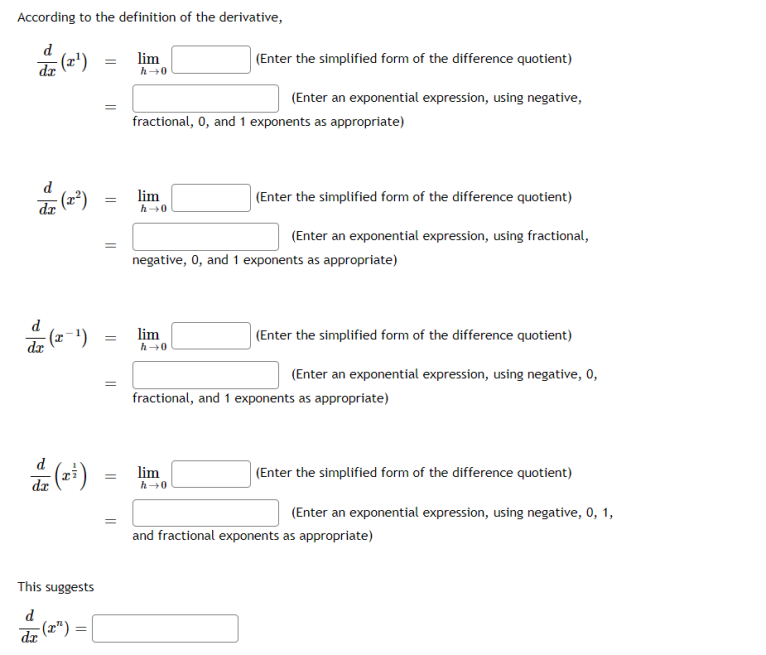According to on of the derivative, lim (Enter the simplified form of the difference quotient) (Enter an exponential expression, using negative, fractional, 0, and 1 exponents as appropriate) lim |(Enter the simplified form of the difference quotient) h0 (Enter an exponential expression, using fractional, negative, 0, and 1 exponents as appropriate) d (x-1) lim h0 (Enter the simplified form of the difference quotient) da (Enter an exponential expression, using negative, 0, fractional, and 1 exponents as appropriate) (+) lim (Enter the simplified form of the difference quotient) dr (Enter an exponential expression, using negative, 0, 1, and fractional exponents as appropriate) This suggests d. -IN
According to on of the derivative, lim (Enter the simplified form of the difference quotient) (Enter an exponential expression, using negative, fractional, 0, and 1 exponents as appropriate) lim |(Enter the simplified form of the difference quotient) h0 (Enter an exponential expression, using fractional, negative, 0, and 1 exponents as appropriate) d (x-1) lim h0 (Enter the simplified form of the difference quotient) da (Enter an exponential expression, using negative, 0, fractional, and 1 exponents as appropriate) (+) lim (Enter the simplified form of the difference quotient) dr (Enter an exponential expression, using negative, 0, 1, and fractional exponents as appropriate) This suggests d. -IN
Calculus: Early Transcendentals
8th Edition
ISBN:9781285741550
Author:James Stewart
Publisher:James Stewart
Chapter1: Functions And Models
Section: Chapter Questions
Problem 1RCC: (a) What is a function? What are its domain and range? (b) What is the graph of a function? (c) How...
Related questions
Question

Transcribed Image Text:According to the definition of the derivative,
lim
(Enter the simplified form of the difference quotient)
h+0
(Enter an exponential expression, using negative,
fractional, 0, and 1 exponents as appropriate)
(„7)-
dz
|(Enter the simplified form of the difference quotient)
lim
h0
(Enter an exponential expression, using fractional,
negative, 0, and 1 exponents as appropriate)
d
(x-1)
lim
(Enter the simplified form of the difference quotient)
da
(Enter an exponential expression, using negative, 0,
fractional, and 1 exponents as appropriate)
lim
(Enter the simplified form of the difference quotient)
dr
h0
(Enter an exponential expression, using negative, 0, 1,
and fractional exponents as appropriate)
This suggests
d
= („7) P
Expert Solution
This question has been solved!
Explore an expertly crafted, step-by-step solution for a thorough understanding of key concepts.
This is a popular solution!
Trending now
This is a popular solution!
Step by step
Solved in 2 steps with 2 images

Recommended textbooks for you

Calculus: Early Transcendentals
Calculus
ISBN:
9781285741550
Author:
James Stewart
Publisher:
Cengage Learning

Thomas' Calculus (14th Edition)
Calculus
ISBN:
9780134438986
Author:
Joel R. Hass, Christopher E. Heil, Maurice D. Weir
Publisher:
PEARSON

Calculus: Early Transcendentals (3rd Edition)
Calculus
ISBN:
9780134763644
Author:
William L. Briggs, Lyle Cochran, Bernard Gillett, Eric Schulz
Publisher:
PEARSON

Calculus: Early Transcendentals
Calculus
ISBN:
9781285741550
Author:
James Stewart
Publisher:
Cengage Learning

Thomas' Calculus (14th Edition)
Calculus
ISBN:
9780134438986
Author:
Joel R. Hass, Christopher E. Heil, Maurice D. Weir
Publisher:
PEARSON

Calculus: Early Transcendentals (3rd Edition)
Calculus
ISBN:
9780134763644
Author:
William L. Briggs, Lyle Cochran, Bernard Gillett, Eric Schulz
Publisher:
PEARSON

Calculus: Early Transcendentals
Calculus
ISBN:
9781319050740
Author:
Jon Rogawski, Colin Adams, Robert Franzosa
Publisher:
W. H. Freeman


Calculus: Early Transcendental Functions
Calculus
ISBN:
9781337552516
Author:
Ron Larson, Bruce H. Edwards
Publisher:
Cengage Learning